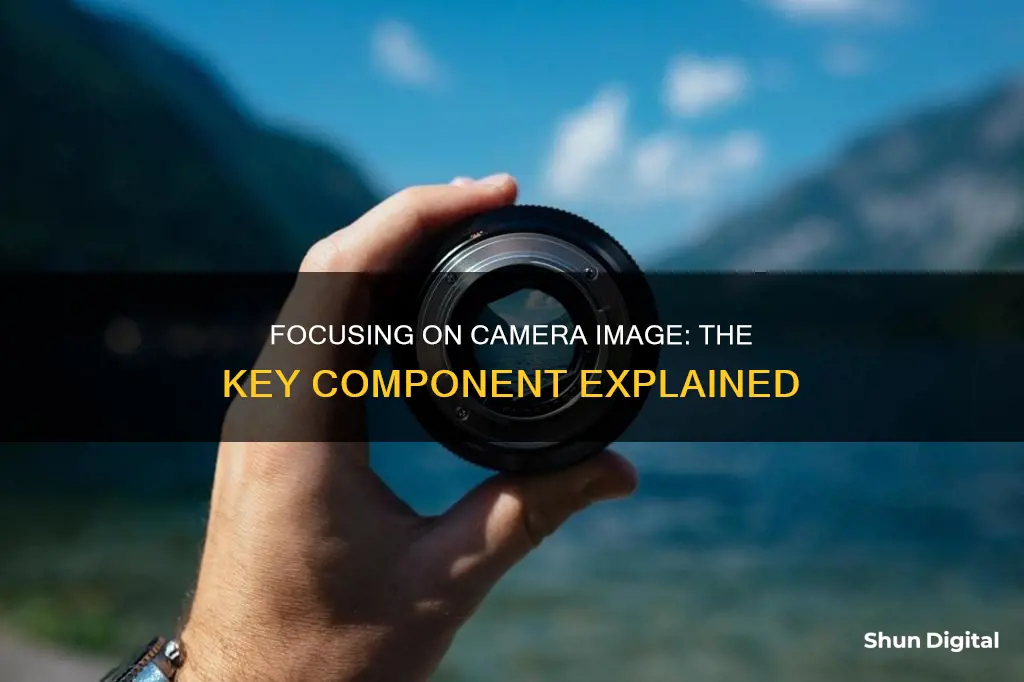
Focusing is a fundamental aspect of photography, and a camera's ability to focus light onto a photosensitive surface is crucial for capturing clear, sharp images. The camera lens plays a pivotal role in this process, consisting of curved, translucent material that bends and slows down light to direct it onto the film or digital sensor. This process is known as focusing and can be adjusted manually or automatically.
Modern cameras typically feature autofocus capabilities, employing tiny motors within the lens to adjust the focus based on the detection of contrast or phase differences. This autofocus feature can be a lifesaver for photographers, ensuring their images are crisp and clear. However, understanding the basics of manual focus can also be beneficial, especially in situations where autofocus struggles, such as in low-light conditions or when trying to achieve a specific artistic effect.
The camera's lens mount, located on the front of the camera, is the mechanical fitting that secures the lens in place. The lens release button, usually found near the lens mount, is essential for safely detaching the lens when needed.
What You'll Learn

Autofocus vs Manual Focus
The lens of a camera focuses the light to create an image. Modern cameras have the option to autofocus or manually focus.
Autofocus (AF) is the function of a camera to automatically focus on a subject. Most general digital cameras have this function. There are various AF methods, and the available methods differ depending on the model of the camera. Autofocus is generally faster and more convenient than manual focus. It is also more accurate in certain situations, such as tracking focus on a moving subject. This is why sports and wildlife photographers rely on autofocus so heavily.
However, manual focus has its advantages. If your camera is having trouble focusing, such as in low light or low-contrast conditions, manual focus lets you override any issues or make precise adjustments that the camera may have missed. Manual focus also gives the photographer greater creative control.
- Capturing moving objects, such as in sports or wildlife photography
- Capturing scenes with many objects, as autofocus can struggle with foreground objects
- Capturing images in a hurry, as autofocus is generally faster
- Capturing images in low light or low-contrast conditions, as autofocus relies on light and contrast to function
- Capturing magnified scenes, such as in macro photography, as autofocus struggles at high magnifications
- Capturing images where precise focus is required, such as in landscape or portrait photography
In conclusion, neither autofocus nor manual focus is universally superior. The choice depends on the photographer's needs and shooting conditions.
The Chemistry of Camera Batteries
You may want to see also

Autofocus Types: Phase Detection and Contrast Detection
Autofocus systems rely on one or more sensors to determine the correct focus. The two main types of autofocus systems are phase detection and contrast detection.
Phase detection autofocus (PD AF) is achieved by dividing the incoming light into pairs of images and comparing them. It is very fast and good at tracking moving subjects as it doesn't require much computational work from the camera. However, it is more prone to errors and internal misalignment issues.
In an SLR camera, light passes through the lens, hits a reflex mirror and is reflected up through a pentaprism and out through the viewfinder. The centre of the camera's mirror is translucent, and a sub-mirror behind it reflects light down into the base of the camera body, where the AF sensor unit is positioned. The light reflected from the sub-mirror is split into two separate images by prisms and microlenses in the AF sensor unit, each aimed at two lines on the AF sensor corresponding to the active AF point.
If the images hit the two lines precisely, the subject is in focus. The distance between the two images tells the camera how much the lens is out of focus. The AF unit then works out how far to move the lens to bring the subject into focus and in which direction, then drives the lens to that position.
Phase detection autofocus forms part of a very accurate and precise autofocus system that allows high-end SLR cameras to accurately track fast and erratically moving subjects. However, it doesn't work in Live View or movie mode as, in those modes, the camera's mirror is flipped up to allow light from the lens to reach the sensor in a continuous feed.
Contrast detection autofocus (CD AF) works by analysing pixels on the camera's sensor. It is based on the principle that the subject is in focus when contrast is highest. As a result, contrast detection autofocus is slower than phase detection autofocus as it requires the camera to process more data. However, it is far more accurate at focusing on still subjects as there is no need to calibrate the lens.
Contrast detection autofocus is a common method in digital cameras that lack shutters and reflex mirrors. Most DSLRs use this method (or a hybrid of both contrast and phase-detection autofocus) when focusing in their live view or movie modes.
Some cameras use a hybrid of the two systems. For example, a digital single-lens reflex (SLR) camera may use contrast detection autofocus in Live View or movie mode and phase detection autofocus when looking through the viewfinder.
Charging Vintage 8mm Cameras: A Step-by-Step Guide
You may want to see also

Focus Ring
Focusing is a crucial technique in photography, as it determines the sharpness of the final image. The focus ring, located on the lens, plays a pivotal role in this process. By rotating or turning the focus ring, photographers can adjust the lens elements to bring their subject into sharp focus. This manual adjustment of the lens allows for precise control over the plane of focus, ensuring that the desired area of the image is captured clearly.
The focus ring is an essential component of manual focus lenses, where the photographer has complete control over the focusing process. By manipulating the ring, the lens elements move closer or further from the sensor, altering the optical path of light and bringing the desired subject into focus. This manual technique offers a high degree of precision and is particularly useful in situations where autofocus may struggle, such as in low-light conditions or when photographing static subjects.
In contrast, autofocus lenses have become increasingly popular due to their convenience and speed. These lenses utilise a motor to automatically adjust the focus, eliminating the need for manual manipulation of the focus ring. However, autofocus systems may not always produce accurate results, especially when tracking moving subjects or in challenging lighting conditions. In such cases, the manual focus ring allows photographers to fine-tune the focus and ensure their subject remains sharp.
The focus ring is designed to be easy to grip and rotate, allowing for smooth and precise adjustments. Its location on the lens varies depending on the lens model and manufacturer, but it is typically positioned near the front of the lens barrel. Photographers can feel the ridges or grooves on the focus ring, making it distinguishable from other lens components.
It is worth noting that not all lenses have a physical focus ring. Some modern lenses, especially those designed for smartphones or compact digital cameras, may have electronic focus controls instead. These lenses use software algorithms and internal motors to adjust the focus, removing the need for a manual focus ring.
Understanding Dual File Formats in Photography
You may want to see also

Focus Indicator
A camera is an instrument used to capture and store images and videos. The lens of a camera focuses the light, and the viewfinder allows the user to preview the scene. The focus of a camera can be adjusted either automatically or manually.
The focus indicator is a feature in some cameras that helps the user to achieve the correct focus. It is usually located in the viewfinder or on the screen of the camera. When the camera is in autofocus mode, the focus indicator will light up or blink to confirm that the subject is in focus. In some cameras, the focus indicator may also beep to indicate that focus has been achieved.
In manual focus mode, the focus indicator may provide information on whether the focus ring needs to be rotated clockwise or anticlockwise to achieve the correct focus. For example, the Nikon D5000 has a Rangefinder option that replaces the exposure meter in the viewfinder with a rangefinder meter. The markings on the meter indicate whether the focus is in front of or behind the subject, and the user can adjust the focus ring accordingly. When the subject is in focus, the meter will show two small ticks and a confirmation dot.
It is important to note that the focus indicator may not work in certain shooting modes or with certain lenses. For instance, the Canon EOS 80D's focus indicator might not light up if the lens's focus mode switch is set to
Factors Affecting Focus
The ability to achieve correct focus depends on various factors, including the distance between the camera and the subject, the amount of light available, the level of contrast in the scene, and the movement of the subject.
Techniques for Achieving Correct Focus
To achieve correct focus, it is essential to understand the concept of the plane of focus. The plane of focus is the region in space that has the potential to be as sharp as possible in a photo. By adjusting the position of the lens and the camera, photographers can ensure that the subject falls within this plane of focus.
Additionally, photographers can use techniques such as focus locking and recomposing the shot to achieve the desired focus. Focus stacking is another technique where multiple photos with different focus points are combined to create a final image with a greater depth of field.
Action Camera Batteries: How Long Do They Really Last?
You may want to see also

Focus Modes
Focusing is one of the critical factors that determine the success of your photos. Modern cameras come with a range of focus modes that can be used in different scenarios. In this section, we will discuss the different focus modes and when to use them.
Manual Focus Mode (M)
Manual focus mode gives you complete control over the focus of your image. It is achieved by adjusting the lens ring until the subject is in focus. This mode is useful when shooting in low-light conditions or astrophotography, where autofocus may struggle. It is also useful for macro photography, where you want to pinpoint the focus accurately.
Autofocus (AF) Modes
Autofocus modes use complex algorithms and lens motors to focus on the subject. There are three main autofocus modes: single, continuous, and hybrid.
Autofocus Single
This mode is suitable for still subjects such as landscapes, portraits, and still life. The camera will focus on the subject when you half-press the shutter button and take a picture when you fully press it. This mode is called AF-S in Nikon cameras and One-Shot AF in Canon cameras.
Autofocus Continuous
Autofocus continuous mode is designed for moving subjects. The camera will continuously track and refocus on the subject as long as you keep the shutter button half-pressed. This mode is useful for capturing fast-moving subjects like wildlife, children, or sports. It is called AF-C in Nikon cameras and AI Servo AF in Canon cameras.
Autofocus Hybrid
Autofocus hybrid mode automatically switches between single and continuous modes depending on the subject's movement. It is useful for unpredictable subjects like wildlife or children. This mode is called AF-A in Nikon cameras and AI Focus AF in Canon cameras.
Autofocus Area Selection Modes
Autofocus area selection modes allow you to choose the specific area or point in the frame that you want the camera to focus on. The four common types of area selection modes are:
Single Point
This mode allows you to choose a specific focus point in your frame. It is suitable for still subjects or when you need high accuracy, such as in portrait photography.
Dynamic Area
Dynamic area mode allows you to choose a focus point, but the camera can adjust and refocus when the subject moves. It is useful for wildlife or sports photography, where the subject is in motion.
Auto Area
In this mode, the camera automatically finds the subject and chooses a focus point in the frame. It is useful for novice photographers or when you need to focus quickly.
3D Tracking
3D tracking is an advanced mode where the camera can focus on the subject even if you recompose the scene. It is useful for challenging subjects that move unpredictably.
Changing Focus Modes
The process of changing focus modes varies depending on the camera model. In beginner models, you may need to navigate through the menu, while advanced cameras usually have dedicated knobs or buttons for changing modes.
Battery Saver Mode: Impact on Camera Performance
You may want to see also
Frequently asked questions
The camera lens focuses the image.
A camera lens is an assembly of multiple optical elements, typically made from high-quality glass. Its primary function is to focus light onto a camera's film or digital sensor, thereby producing an image.
A camera lens is constructed from a series of lens elements, or small pieces of glass, arranged to form an image accurately on the light-sensitive surface. Each element is designed to reduce optical aberrations or distortions, such as chromatic aberration (a failure of the lens to focus all colours at the same point).
Focusing happens either automatically or manually. Automatic focus, or autofocus, is when the camera system drives a motor to move elements in your lens to change focus. To focus manually, you need to turn a ring or similar mechanism on the lens instead.
Your camera's LCD screen has a focus indicator, which is a box that shows what your camera is focusing on. To prevent focusing problems, you'll need to keep an eye on the focusing indicator whenever you take a photo.







